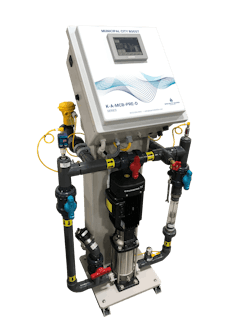Case Study: I/O Keeps Medical-Grade Water Flowing
A single contaminant in water can be life-threatening or even fatal for someone undergoing hemodialysis.
Behind the patient treatment areas in the roughly 7,500 dialysis centers in the U.S. are complex water-purification systems that feed medical-grade water into therapy protocols. Specialty Water Technologies (SWT) is one of the nation’s leading manufacturers of multi-tank, integrated systems which, due to their critical role in healthcare, increasingly use automation to meet tight Federal Drug Administration standards for clean water. Each year, the company installs about 150 water purification systems, custom-manufactured to remove specific contaminants discovered during an initial, comprehensive analysis of local water.
Automated water-quality monitoring systems must account for multiple factors–including chlorine intensity, pressures and pH levels, to name just a few. Reliable, accurate monitoring is essential for producing and ensuring medical-grade water.
While federal standards for drinking water set allowable limits for common chemicals and contaminants, the standards for dialysis water are understandably more stringent. During a single dialysis session, which lasts up to four hours, a patient can be exposed to up to 200 liters of water, according to the Center for Disease Control and Prevention. The amount of permitted arsenic in that volume of tap water, for instance, would be toxic for a dialysis patient.
“We adhere meticulously to federal guidelines of what the water constituents can have for a dialysis patient, so we clean and purify the water,” said Vince Barker, president of SWT, adding that SWT’s built-in automated function provides for real-time tracking. “If any impurities are out of range, we shut down the operation, which protects patients from any harm or even death.” With the arrival of COVID-19 and its disruption of healthcare supply chains, SWT’s existing provider couldn’t keep up with demands for remote I/O cards that are vital to monitoring these purification systems.
“We needed a remote automation solution, and many suppliers simply could not meet demand as quickly as we needed,” Barker said.
Key decision factors
SWT approached Weidmuller USA about its u-remote product to see if it would fit the required specifications.
U-remote is a configurable, simplified I/O that can be used across multiple platforms, including interfacing with virtually any PLC system. Customers can tap into more than 80 I/O cards to tailor its functionality. In this case, u-remote would be used to monitor time-sensitive sensors in the water-purification process.
Another SWT requirement was size, which u-remote was also able to meet due to its slim and compact design, which also avoided any issues when adding it to the control cabinet.
With these requirements addressed, SWT asked for 18 of the UL-listed u-remote systems to be delivered within a week. Weidmuller exceeded the demand by shipping 25 almost immediately. “This component was an exact match and fit like a glove,” Barker said. Even more important, SWT never had to shut down production at any dialysis site.
From its home in the control cabinet, u-remote receives data from analytical sensors found across the system. After they are deciphered and calculated, those sensor data drive operational decisions. U-remote then outputs data to adjust values or downstream processes to ensure the outflow water meets medical grade requirements. Soft-limit alerts delivered by u-remote advise on-site technicians to issues they often can address. More significant hard-limit alarms prompt a system shutdown, which automatically diverts water flow from any patient.
Because purification systems already take up dedicated space at a treatment site, efficiency in the supporting technology that fits in the existing space is important. Between FDA and UL requirements, making changes often takes significant review and approval time, but the Weidmuller approach was designed to easily replace an existing I/O solution. The upgrade can be executed and validated in a day, keeping centers open for patients.
LED lights at each connection point on the u-remote tell users when something isn’t running for easier troubleshooting. During installation, modules are automatically integrated and snapped in, without a need for more hardware or specialized tools.
Ken Crawford is senior director of automation, and Jeff Joyner is southeast district manager at Weidmuller USA.


